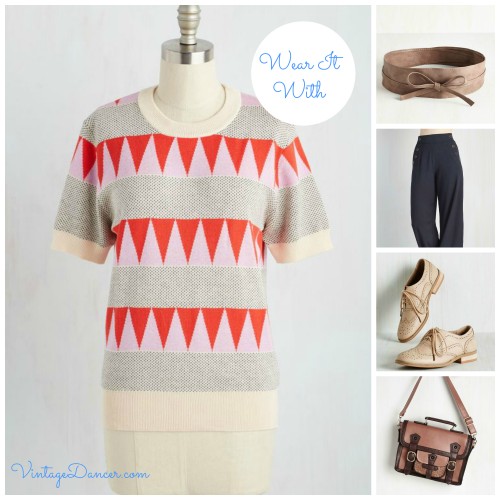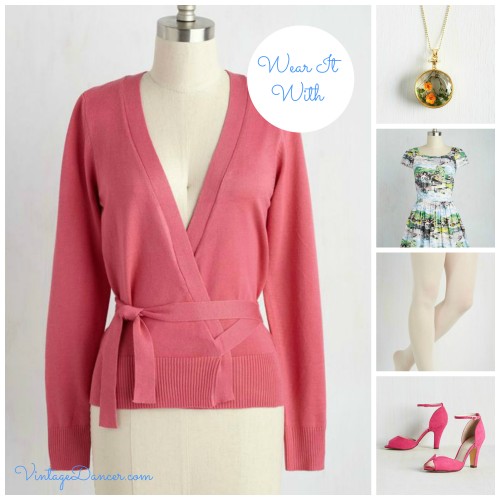Of all the items in a woman’s wardrobe, tops, sweaters, and cardigans are the most versatile. Today, I will be showcasing some wonderful new retro style tops, including Sweaters, Jersey Tops, Pussy-Bow Blouses, and Cardigans. I know that my wardrobe is mostly comprised of blouses and cardigans; and that is for a good reason. They are ever versatile, and a blouse or top layered with a cardigan can be worn in practically any weather! Retro style sweaters and cardigans have the advantage of being able to layer them over dresses too, giving you even more outfit options.
The Gibson Girl
Separates have existed in women’s wardrobes for hundreds of years, but it wasn’t until the 20th century that they became more widely worn. At the end of the 1800s, the Gibson Girl look became popularized, derived from the illustrations of Charles Dana Gibson. The Gibson Girl image was one of femininity, but balanced with a strong sense of independence. This was a more feminized version of the ‘New Woman’; the Gibson Girl would be confident, strong and athletic, but conversely would still represent the socially accepted amount of femininity required of the time.
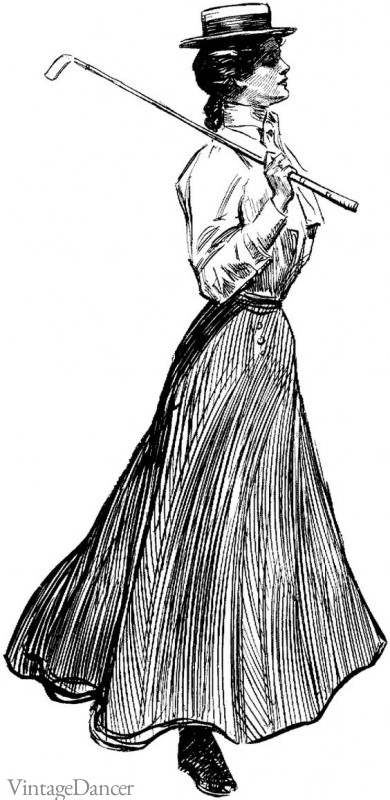
A ‘Gibson Girl’ illustration by Charles Dana Gibson
The Gibson Girl would often be depicted doing leisurely pursuits, with hair piled high atop her head and tiny waist nipped-in exaggeratedly. She would usually be wearing a lacy decorative blouse, cut high to the throat to adhere to standards of decency and etiquette of the time (both of the era and the actual time of day that the clothing was to be worn). The blouse would feature enormous ‘leg o’ mutton’ sleeves, which only sought to further enhance the slenderness of the waistline in contrast.
Around the same time, the craze for athleticism and fitness acquired a new outlet to facilitate this inclination – the bicycle. Once again, the blouse formed an important element to the outfit of the cycling lady, along with other new innovations in attire – bifurcated garments.
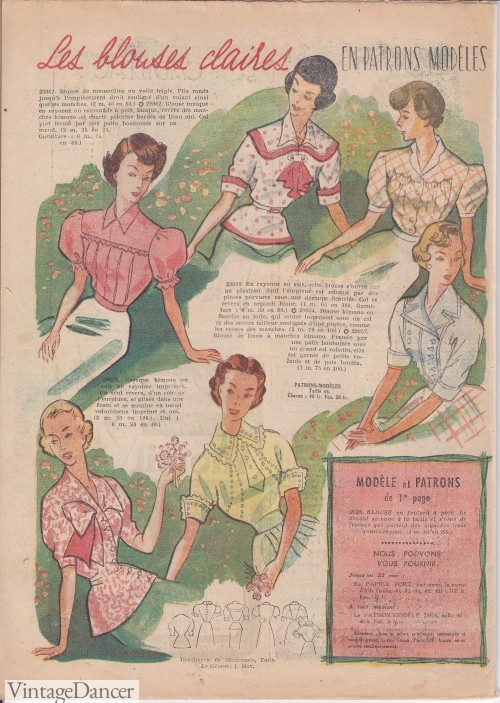
An array of Spring Blouses in Le Petite Echo de la Mode, May 1949
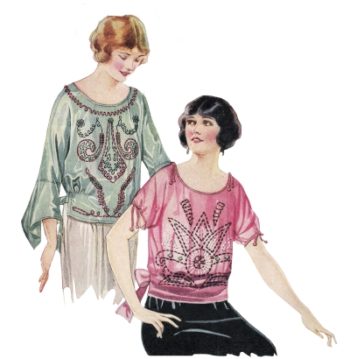
1922 Blouses, embroidered
As WWI progressed, women were needed to fulfill more practical roles, and their wardrobes needed to reflect that change.
By the 1920s, the blouse was worn un-tucked to compliment the long, fluid lines of the decade. The hemline would usually feature a waistband which would sit on the hip over the skirt. Innovations in fabric production paired with a growing desire for comfort led to the popularity of the jumper-blouse, cardigan, and sweater. This trend was to continue through to the following decades, with designers and fashion houses producing ready-to-wear collections to appease the appetite of the fashion conscious.
Sweaters
From the 1930s onwards, sweaters became more figure fitting to reflect the current trends. Sleeves became shorter, and featured little gathers at the sleeve head to ‘puff’ out at the shoulders. The length was cropped, hitting just below the waistline to show off the torso.
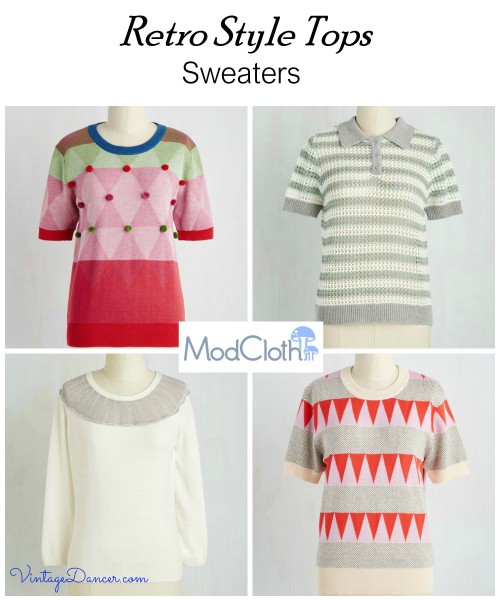
Cute retro style sweaters from Modcloth
By the 1940s, with the onset of WWII, women were called upon to take up their knitting needles for servicemen and women. During this time, due to the Austerity restrictions, home knitting became extremely popular. Wool companies released pattern leaflets featuring the typical stripes and Fair Isle designs, but also some more elaborate motifs – flowers, color blocking, and even parrots were evident.
In keeping with the Make Do and Mend attitude, old garments were sometimes unraveled, with the wool being allocated to a refashioned garment once the yarn had been soaked and dried.
Pair a cropped sweater with loose, wide legged trousers, nipped in at the waist with a belt for a 1940s look.
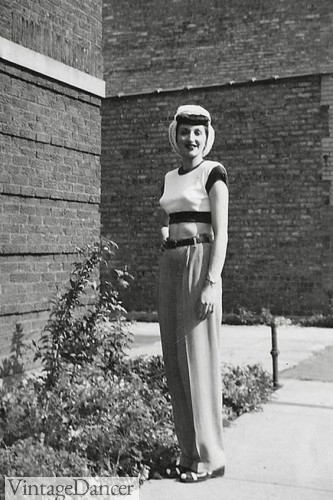
A 1940s look with crop sweater top, wide leg pants, belt, snood and sandals.
Cardigans
Twinsets – a cardigan worn over a matching sweater, were popular in the 1950s, and were an easy way of coordinating an outfit and adding an extra layer if the climate was cool. These were often worn with circle skirts or pencil skirts, and accessorized with a chiffon scarf.
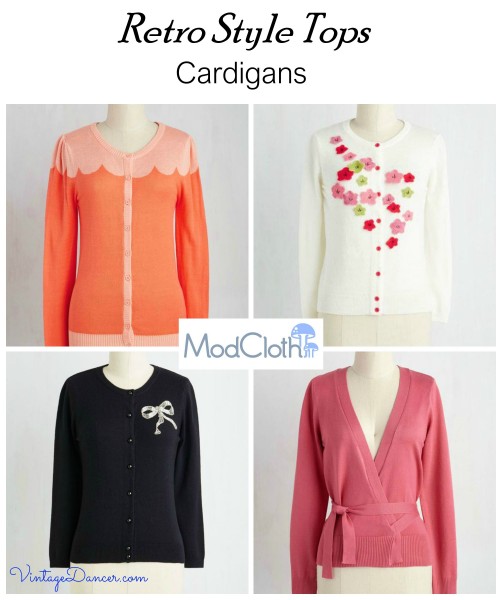
A selection of great 1950s style cardigans available from Modcloth
As Austerity restrictions finally lifted, people generally favored shop-bought knits over homemade. Machines in factories ensured smooth knits, with no dropped stitches or loose tension. During this time, knits were worn even tighter, giving rise to the popular ‘Sweater Girl’ title. Women would wear spiral-stitched bras to give them a pointy, almost weapon-like silhouette.
Pair a cardigan with a pencil skirt or circle skirt for a feminine 1950s look, or layer over your favorite dress to add warmth and interest.
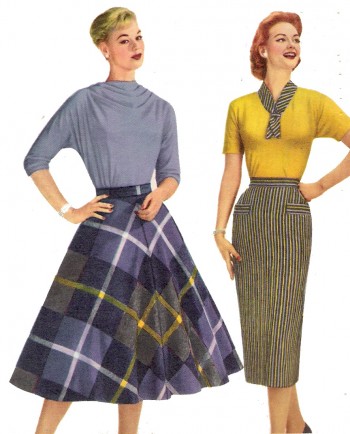
1957 Skirts and sweater tops. So classy!
Jersey Tops
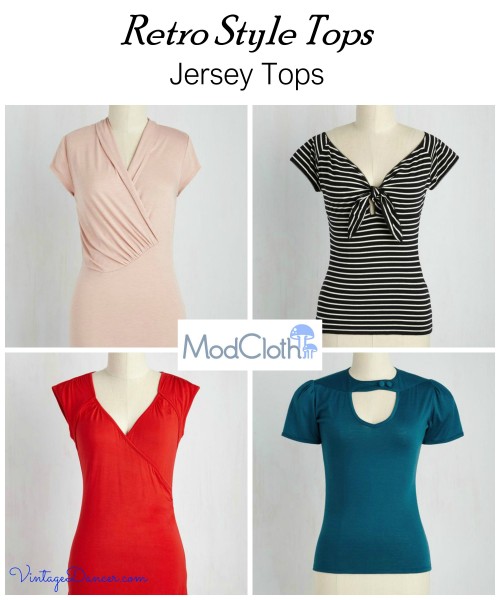
Perfectly versatile, choose one of these jersey tops from Modcloth for a retro style
As the Sweater Girl look became popular, similarly tight-fitted jersey tops also became a wardrobe staple in the 1950s and 1960s. Easy to wear and easy to care for, these tops were seen as an alternative to the blouse. Wear with fitted Capri pants for a late 1950s look, or team with a pencil skirt for a streamlined professional silhouette.
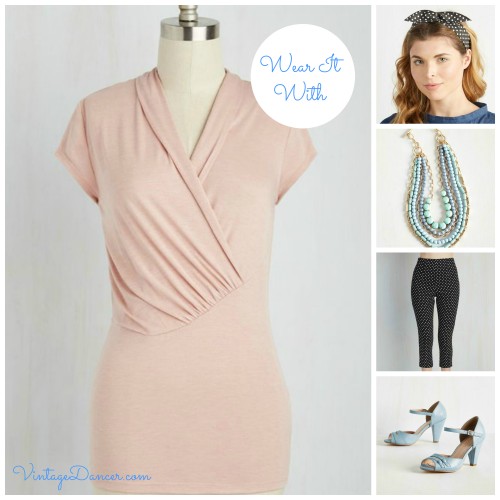
Team a jersey top with capri pants and a headscarf for a mid century style
Pussy-Bow Blouses
The Pussy-Bow blouse is an item of feminine attire which actually originated from our male counterparts’ dressing room. Indeed, the blouse itself is a variation of the male shirt, designed to fit the female figure and aesthetically appear more feminine than a male shirt. The bow part derives from a male tie. Ties, cravats and bow ties have long been an integral part of a gentleman’s closet, and as women started to gain more independence in the early 20th century, a variation filtered down into the female wardrobe.
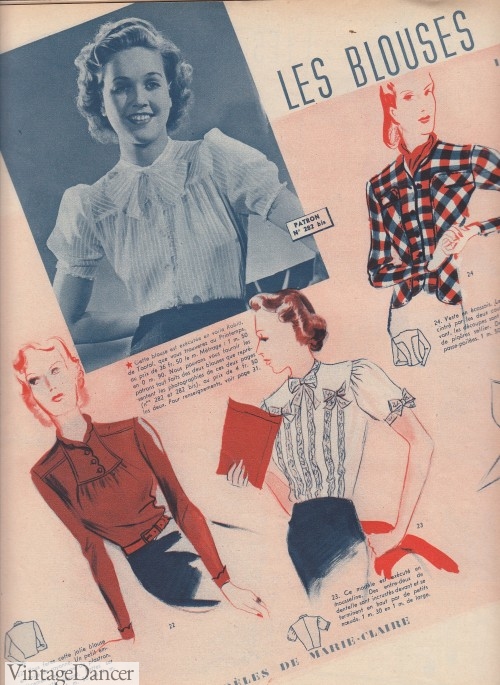
Pussy-Bow blouse photographed in Marie-Claire, March 1938
As women were given more freedom to participate in leisurely pursuits and physically move herself around town on her newly acquired bicycle, she also started to yearn for equality with men. This led to an adoption of male fashions into the female wardrobe, but they would often be ‘filtered down’ to retain a strong sense of the feminine.
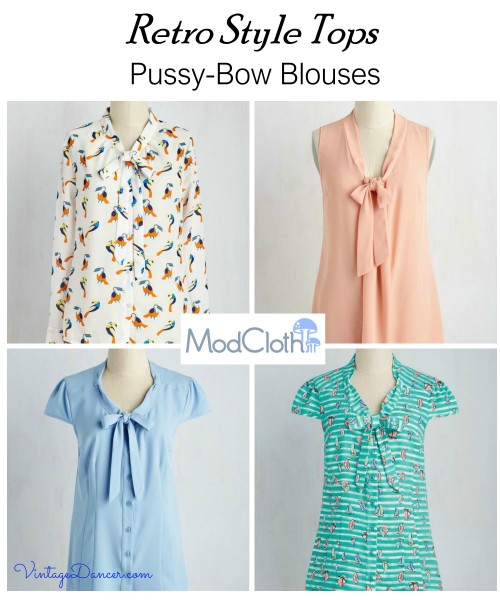
A selection of pussy-bow blouses available from Modcloth
The Pussy-Bow blouse is loose and billowy, which retains movement and fluidity. Extremely versatile, this style has been popular for much of the 20th century. In the 1930s, women wore large, exaggerated bows, which gradually diminished in size as the years progressed. The 1970s saw a resurgence of the Pussy-Bow blouse, and it hasn’t strayed too far from our wardrobes since.
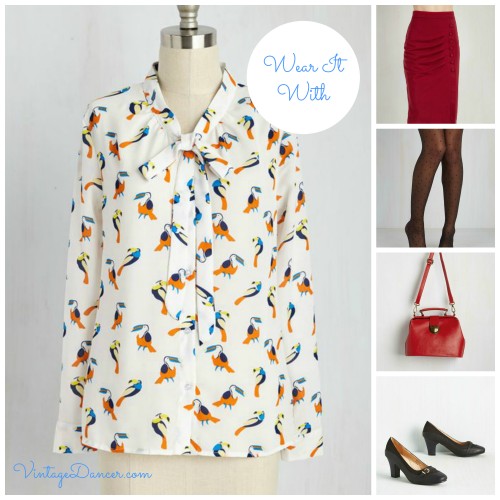
For a smart but comfortable look, team a pussy bow blouse with a pencil skirt and smart shoes
Pair with a straight skirt for a comfortable, formal style which has hints of the 1930s.

1930s Polka dot bow blouse and long skirt.
Debbie Sessions has been teaching fashion history and helping people dress for vintage themed events since 2009. She has turned a hobby into VintageDancer.com with hundreds of well researched articles and hand picked links to vintage inspired clothing online. She aims to make dressing accurately (or not) an affordable option for all. Oh, and she dances too.
